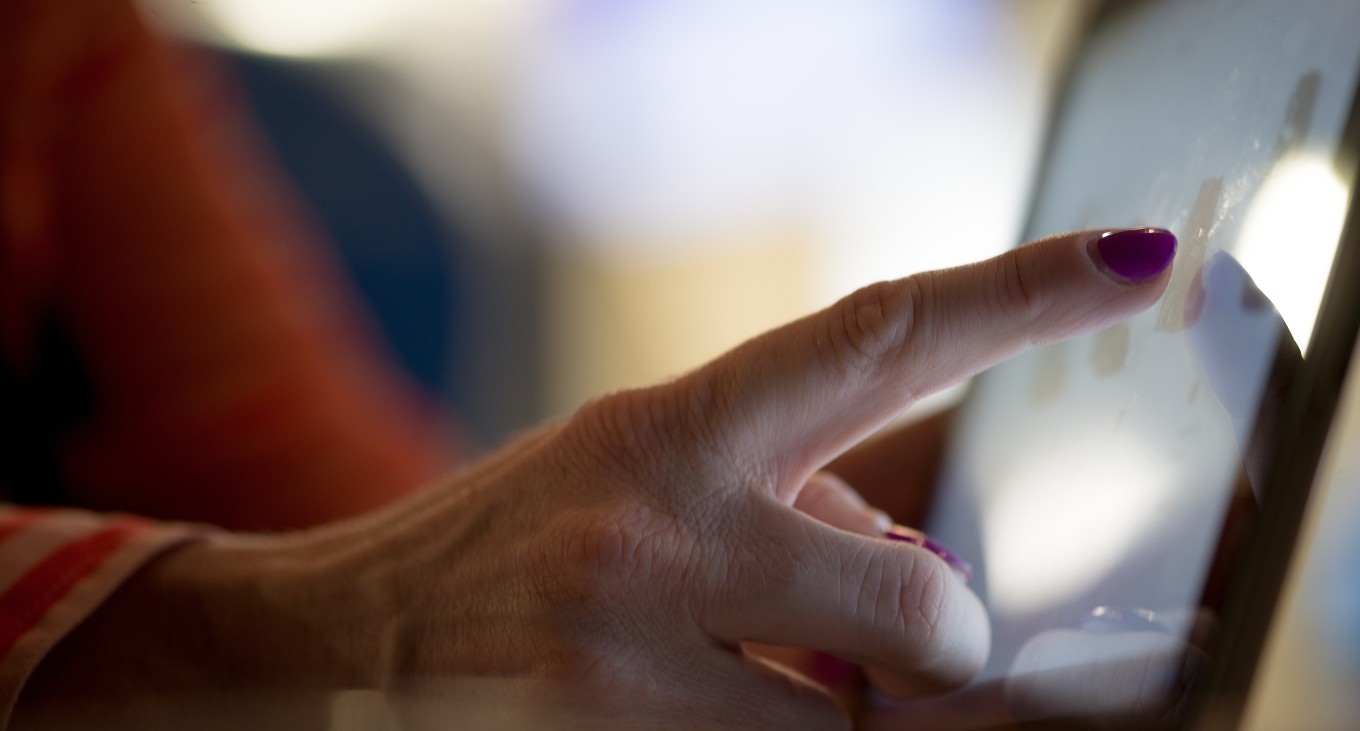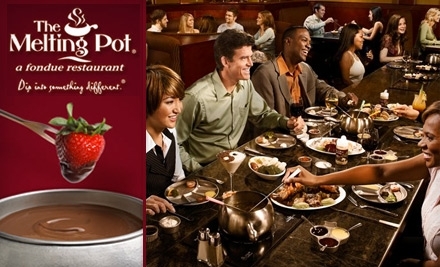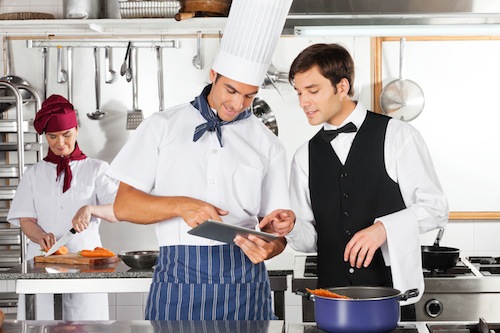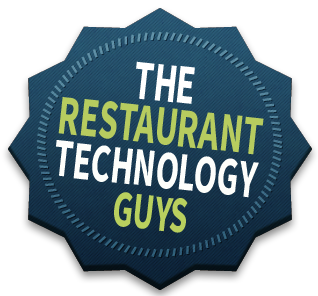
If you’ve been in the restaurant business for a while, you may think you’re too accustomed to your legacy POS system to make the switch to a new one. You’ve seen your colleagues and competitors upgrade their systems and you’re coming to terms with the truth: a modern POS system can lead to new business, less hassle and greater efficiency for your restaurant. And while the transition may seem daunting, the benefits are likely too good to pass up, especially in such a competitive market.
Through the process, keep in mind these keys to making your POS transition as painless as possible:
By incorporating these best practices into your plan, you can ease your transition to a modern POS platform and take your restaurant into the 21st century.
Step #1 – Ask associates about their experience
Fortunately, there are thousands of restaurants and other businesses that been in the exact same situation. If you’ve been in the industry a while, you likely know other restaurateurs and small business owners who have made the transition to a modern POS system. Ask them about their experiences to get a picture of the challenges you will face throughout the process.
What kind of questions should you ask to get the information you need? Below are a few that should be helpful:
Online reviews are helpful as well, but it is definitely worth taking the time to talk to someone you know so you can ask any specific questions that the internet may not address.
Remember that you are not necessarily trying to find the best POS system money can buy—just the one that will work best for your restaurant.
Step #2 – Involve your staff
Only you can decide what system to implement, but it’s also important that you ask your staff their thoughts.
Your staff is on the frontline and will be using the restaurant POS system as much, if not more than you. So, it makes sense to take into account their needs as well as yours when making your decision.
This process can also serve as a sort of “pre-training” by introducing your staff to some of the important concepts and possible changes they will encounter. If you are considering a major switch, like one from a legacy to a mobile POS, ask them if they have any anxieties or concerns regarding the change.
Then, keep them involved as you weigh the options and begin installing your new system. Continue to brief them on your decisions and ask them for feedback so they never feel left out of the process. The more engaged your employees are throughout the installation of your new POS system, the more comfortable they will be with it when it goes live.
Step #3 – Make a choice
Now that you’ve learned how to research and engage your employees, it is time to determine what features your restaurant needs and, ultimately, what POS system you want to go with.
One of the first questions you need to ask about your next restaurant POS is whether or not you want a mobile system. Mobile point-of-sale systems offer a range of features that can revitalize your restaurant’s preparation and service processes. Consider this option if you are ready for significant changes in the way your restaurant operates.
A mobile POS system enable your servers to take and send orders, charge customers, handle electronic signatures, and show suggested tip options, all from the table. These types of features generate extra efficiency which can lead to improved table turn and better revenue.
However, many restaurants prefer not to implement such a significant change and choose to stick with a stationary POS option. For these businesses, a more modern system can still offer a slew of time-saving features while taking up less space than legacy systems.
While the choice between a mobile and stationary system will be one of the most influential decisions you make, there are some questions that are important to ask:
#1. Does the system track and compile data to help you manage your business?
Most modern POS systems offer much more sophisticated data tracking and business analytics features than legacy systems. Weigh these against your management practices to make a decision that works for you.
#2. Does the interface work with your methods/does it offer significant customization?
Only you and your staff know what works best for your restaurant. You may want to customize your new interface so it resembles your current one to minimize the need for training, or you may want to overhaul your interface to improve efficiency.
#3. Is the system secure?
A digital POS has to be secure, so make sure that your new system is PCI compliant and meets other cybersecurity guidelines so you never experience a hack or other emergency. With plenty of high-profile examples in the past year, you want to keep yourself and your customer’s data safe.
#4. Does the new POS work well with online ordering?
If your restaurant receives a lot of business through online orders, you’ll want to make sure your new system supports that. Some systems can send orders straight to the kitchen from the web, saving a step for your restaurant’s host or cashier. This is an especially useful POS feature for business such as burger joints or pizza parlors.
If you don’t already have several specific requirements in mind for your new POS, these questions will help get you started with the research process. As you learn more about the options, you’ll develop an understanding of your needs so you can choose the right system for your restaurant— and then start the transition.
We hope these tips and questions have been helpful to you as you take the important step of updating your POS!
Serious about updating your POS? Check out the Northstar POS system to improve the power and effectiveness of your restaurant!
 Readers familiar with our blog know that we believe tablets are the future of restaurant operations.
Readers familiar with our blog know that we believe tablets are the future of restaurant operations.If you’re considering a tablet-based upgrade your POS system, you might be wondering where the best place for your tablets would be. In the servers’ hands? In the kitchen? The front desk? All of the above?
We’ve identified 4 places tablets can give your restaurant a boost. Adding tablets to these crucial touch points in your restaurant can increase sales, improve efficiency, engage customers, encourage repeat business, and create a better overall experience for guests and staff alike.
 A wireless connection from the wait staff to the cooks can save a considerable amount of time. Servers no longer have to walk to the nearest POS terminal to enter order information.
A wireless connection from the wait staff to the cooks can save a considerable amount of time. Servers no longer have to walk to the nearest POS terminal to enter order information.
Tablets also offer wireless payment and receipt options – which is an opportunity to capture your customer’s email addresses – or connections to multiple printers in the restaurant so servers can print checks without returning to the nearest kiosk.
While this new-and-improving technology can streamline your operations, restaurant managers shouldn’t be too quick to replace staff with digital devices. Implementing tablets into your operation will take some time, and computers can’t replicate the experience of person-to-person interaction. (Yet.)
Choosing a tablet-based operating system can also reduce equipment and update costs compared to traditional POS systems. The savings can be significant for new restaurants, but the cost of a transition might be intimidating for restaurants with an existing POS system.
As OpenForum points out, the Pink Rose Restaurant & Lounge in Portland, Ore., opted for an iPad-based system that cost about $6,000. The owner said that a traditional POS system would have cost $15,000 to $20,000, and would not include the free and frequent updates available through the tablets.
Tablets can improve operations for your back-of-house crew as well as the serving staff. “There’s only so much productivity you can gain from FOH [tablet] uses,” says National Restaurant Association executive vice president and general counsel Dave Matthews. “There are actually more back-of-house uses that have an impact on productivity and profitability.”
With a mobile POS system, management and kitchen staff can also monitor things like inventory levels, the freshness of their ingredients, and sales data in real time. Tablets can also be used to automate and track details like freezer temperatures, cleaning schedules, HAACP compliance and more. Finally, managers and staff can adjust schedules and shifts, also in real time, from any smart device.
In addition to the back-of-house applications listed above, tablets can ease operations in the kitchen too.
Instead of reading and discarding dozens of paper tickets per night, a portable touchscreen interface can display all of the information your chefs need to complete their orders, as well as a running clock to monitor preparation times. While some considerations have to be made for challenging kitchen conditions, the benefits are clear.
 We have written in detail about the benefits of tabletop ordering systems, and those benefits still apply to restaurateurs willing to invest in these upgrades. As a reminder, tabletop tablet benefits include:
We have written in detail about the benefits of tabletop ordering systems, and those benefits still apply to restaurateurs willing to invest in these upgrades. As a reminder, tabletop tablet benefits include:
Giving guests control. Ordering from a tablet at their table allows guests to enter special requests, substitutions, and flag ingredients for food allergies. Also, studies show that guests who order via tablet often spend more per order, thanks to the ability to customize and add to their selections.
Data collection. Tablet orders provide all kinds of information, including what your customers are ordering, when they order it, how they like to pay and more. Monitoring and analyzing this data can lead to new marketing opportunities and more efficient restaurant operations.
Staff focused on customer experience. Connecting guests directly to the kitchen with a tabletop ordering system allows wait staff to expedite orders quickly and ensure guests are enjoying their visit.
 The Melting Pot has announced that all 125 of its locations across the United States will be integrating CBS’s tablet ordering system known as NorthStar Order Entry. The change is expected to happen over the next three years.
The Melting Pot has announced that all 125 of its locations across the United States will be integrating CBS’s tablet ordering system known as NorthStar Order Entry. The change is expected to happen over the next three years.
The Melting Pot tested NorthStar Order Entry at several of its locations and experienced positive results and feedback, including faster service and better tips! So they decided it was a worthwhile investment that would have an excellent ROI by increasing profits, reducing waste, and improving the customer experience. Win-win!
NorthStar Order Entry is a POS (point of sale) system that offers five ways to take orders: staff-facing POS, guest-facing (tabletop), lobby kiosk, online, and mobile devices. NorthStar Order Entry also features WorldView monitoring, putting all your locations on a single page and keeping a watchful eye on the system’s vitals.
The best part is that it’s a cloud-based software, so ALL data is stored in a single location online and can be easily managed from anywhere you have internet access.
Check out this quick, fun video about how NorthStar Order Entry works:
POS systems are a wise investment for busy restaurateurs because they reduce customer wait times, eliminate server error, and send orders to the kitchen or bar immediately for fast service.
Gone are the days of desperately trying to catch a server’s eye in order to get a refill or order something else from the menu. Tabletop POS systems put the control in the customer’s hands (literally) and enable them to open tabs and immediately start ordering. Of course, the servers will be around when guests need them – but now they are freed up to focus on improving the customer experience, rather than running around like chickens with their heads cut off.
A great customer experience will result in better tips and more orders, as well as customer loyalty and word-of-mouth referrals.
Another feature of a great POS system like NorthStar Order Entry is the ability to gather customer data and do targeted marketing campaigns, customer loyalty programs and the like. Training your staff is super easy and quick, and CBS offers excellent 24/7 customer support should you have any questions or concerns about the software.
Other restaurants that use NorthStar Order Entry include Stacked (which will be opening a location in fall 2015 in Huntington Beach!), Chili’s, Buffalo Wild Wings, and Applebee’s.
Congratulations to The Melting Pot!
Melting Pot to use NorthStar Order Entry Nationwide: Check out the OC Register article here.
At this point, almost every restaurant owner has heard of online ordering. And for thousands of business owners around the world, online ordering systems have already boosted revenue, increased ticket prices, streamlined ordering, and added a host of other benefits. But that doesn’t mean that some restaurant owners aren’t wary of adopting the new technologies and practices associated with online ordering. Every business owner has a right to choose how to run their business, and lots of restaurant owners simply don’t choose to look into an online ordering solution.
However, for many restaurant owners, the choice not to sign up for an online ordering system is based on some persistent myths about the technology. Every business owner should be able to make whatever choices they see as being best for their business, but it’s best when those choices are based on solid facts rather than myths and misconceptions.
So, for all of the restaurant owners out there still on the fence about a service like Orders2Me, here are the 3 most persistent myths about online ordering.
For many restaurant owners, it seems like common sense that a service as new and revolutionary as online ordering would come along with a huge price tag. But for most business owners, adopting an online ordering system will actually lead to big net profits.
Unless your POS comes natively with online ordering (like NorthStar Order Entry), there are two main pricing models for online ordering systems. Most big vendors like Eat24 and GrubHub take a percentage of every ticket that you process with their systems, essentially cutting down on your profits per dish. And for these types of online ordering systems, prices can indeed be prohibitive; your dishes probably already have a narrow profit margin, and the percentage that Eat24 or another big company skims off of the top can mean that your orders barely make you anything after labor costs, or even result in a small loss per order.
But there is a second type of online ordering pricing system, which vendors like Orders2Me think is a little more realistic. Using a pre-built, user-friendly portal, restaurant operators pay a small monthly fee for as many orders as they can process. With a pricing model like that, restaurant owners can quickly get ahead, since the more orders you sell to online customers, the smaller per dish fee you really pay. If a restaurant owner chooses the right system for their goals, utilizes a service with a small monthly fee and brings in even a humble number of orders, online ordering can end up being very profitable. It’s no myth that some systems are too expensive, but choose the right one, and expense concerns are squashed.
Restaurants can be chaotic, and for the business owners that manage them, it can seem like a daunting idea to throw in any variable that will shake things up. Specifically, restaurant owners often shy away from adopting an online ordering system because they think that online ordering systems will take a lot of training to adopt.
For most online ordering systems though, there is very little impact on restaurant staff, and very little training required for adoption. From the server and front of house staff’s perspective, there are really no big changes. In fact, your server staff may not have to field as many phone orders, giving them time to focus on their guests in the dining room. As for the back of house staff like chefs and cooks, there isn’t too much change either if you choose the right system. Eat24 integrates with your existing order printing system, and allows your kitchen staff to process online orders in stride with the ones that come in from servers. Generally, there’s little to train your staff on when implementing online ordering.
It’s obvious how much online ordering does for customers, but for many restaurant owners, it doesn’t seem like online ordering will do much for their business. This is a big myth, and a hard one to unpack. But restaurant owners should know that if they pick the right online ordering system, they will see some immediate benefits to their business. From increased ticket prices to more take-out and delivery orders, you’re putting your menu in front of hungry internet users who are just waiting for you to satisfy their hunger pangs in a hurry. This ultimately means more profit for your restaurant and a much more efficient restaurant to boot. If you want more info about why this myth is false, browse the rest of our blog.
Is online ordering for every restaurant owner? Not always. But for those that want to put their menu to work online to help feed hungry browsers, the benefits should very much outweigh the myths. And when clear decisions are marred by misconceptions, your business may be missing out on a major slice of the pie!
 Rafi Cohen, a graduate of Baruch College & Brooklyn native is the Co-Founder at Orders2Me, an online ordering platform that gives restaurant owners all the features they need to grow their business in the digital age.
Rafi Cohen, a graduate of Baruch College & Brooklyn native is the Co-Founder at Orders2Me, an online ordering platform that gives restaurant owners all the features they need to grow their business in the digital age.

Customers envision that behind those double doors are brilliant chefs (usually European – why is that?) in clean white coats and tall hats, hard at work creating their culinary masterpieces, floating about the kitchen with inspiring classical music playing in the background, a glistening of sweat on their brow. It’s a fantastic mystery, like the inner workings of Willy Wonka’s chocolate factory.
We’ll just let them carry on with that fantasy…but we know the truth. While the kitchen is indeed the heart of a restaurant, often it ends up being more of a chaotic madhouse than a well-oiled machine. It’s hot, greasy, noisy, and (hopefully) incredibly busy in there. People are yelling orders, bumping into one another, and scurrying from station to station to get orders out on time.
Streamlining Service to Focus on Food
Any restaurateur knows that in order to create customer loyalty, the customers have to be happy. And to keep them happy, you have to provide great food and great service. We can’t help with the food (though we are more than happy to eat it and provide our feedback), but we CAN help with the service. Obviously your wait staff is key to creating a positive customer experience, but another very important component of great service happens in the kitchen.
The right kitchen management program will keep your kitchen organized and running smoothly, with specific (and correct!) orders coming in for all the kitchen staff to see. You’ll be able to keep the hot food hot and the cold food cold, arrange it beautifully on the plate, and place it in front of the guest in a timely manner. This entire process can be streamlined with an automated kitchen management system.
Related Post: 5 Tips for Adding Touchscreen Technology to Your Kitchen
Here are just a few of the benefits of an automated kitchen management system:
A well-constructed kitchen management system will come with a terminal that is built to withstand the heat and humidity common to the kitchen environment.
Products such as Northstar Order Entry, Northstar Recipe Viewer, QSR Automations ConnectSmart Kitchen, and Bematech KDS Manager v3.1 are all valuable software that can provide your business with more metrics and provide your staff with the information they need to do their jobs correctly and efficiently.
These softwares will allow you to view, edit, and keep secure your beloved recipes; plan ahead for rush periods; transfer orders to other (less busy) kitchen stations in a rush; move a rush order to the top of the queue; view statistical reports for each station; and more. Pretty much anything that’s been necessary but difficult to keep track of manually can now be automated, making your life easier and the information much more accurate, and helping your business stick around for the long haul. Whew!

Here’s the typical restaurant scenario: After guests are seated, they wait for a server to show up with menus. They may take drink orders, but who knows when they’ll be back to ask about appetizers, or answer questions about the menu. Then there’s that inevitable awkward moment when you stare intently at your server, waiting to catch his eye so you can flag him down for a refill or get your check. We’ve all been there, it’s not fun.
Now imagine this one: Once seated, customers can immediately view the menu via their tableside ordering system. (Check out the Northstar Order Entry POS!) They can place an order as soon as they are ready, and order additional items whenever and as often as they’d like. The servers are available to answer questions and meet the customers’ needs as they dine. After the meal, they can pay and leave, again via their tabletop ordering system.
Which scenario would you prefer? We’re guessing the latter. And guess what: that’s the same one most of your guests prefer too.
Not sure whether to take the plunge and invest in a table ordering system for your restaurant? Or perhaps you’ve already made the decision to go for it and need some validation that you made the right move?
Your pals, The Restaurant Technology Guys, are here to provide valuable, useful information about how your restaurant can benefit from a table ordering system.
Speaking of useful info, check out our related post, Tips for Using Tabletop Tablets for Guest Ordering.
A table ordering system is a great way to let your customers know you are here for the long haul and want to be relevant to them. Set your restaurant apart with technology that makes the guest experience better, your job easier, and your business more lucrative!

A table ordering system means your guests have more control. (Who doesn’t want to be in control, right?) Review our restaurant scenarios 1 and 2 above.
Tableside ordering starts the guest off on a positive note. After being greeted with a friendly smiling face at the host/hostess station, then led to their seats, the guests can sit and chat for a while, or get down to business – up to them. Servers will come around to introduce specials and answer questions, but the rest is up to the customer.
The system can accommodate special requests and substitutions, and allow guests to flag ingredients for food allergy. (It can even offer tableside entertainment, such as games or music!)
When guests have finished their meals, they can pay and leave at their convenience – again, no waiting for the server to close them out.
NOTE: Ideally, these features free up servers to attend to the other needs of the customers as they dine. Tablets should not be a replacement for quality, experienced servers who can anticipate the needs of the customers. Rather, this technology is simply a perk to enhance efficiency and improve the customer experience, which leads us to #2.
The table ordering system described above improves 1) the accuracy of orders, as it eliminates server error when taking orders, and 2) the speed and efficiency of service, both of which contribute to a better customer experience.
People want more control over their dining experience. Tableside ordering gives guests that control. And guests in control are happy guests, resulting in improved customer loyalty AND more word-of-mouth/social media recommendations.
While adding new technology to a restaurant takes some getting used to, the learning curve with a table ordering system should be fairly easy. A good manager will put measures in place to ensure a smooth transition for both the wait staff and kitchen staff. And chances are, the customers are already familiar with iPads (or other handheld devices) and smartphones. As long as the ordering software is intuitive and simple, it will be easily navigated by the customer.
Not only will customers enjoy being in control of their ordering and paying experiences at your restaurant, which will increase repeat visits as well as word-of-mouth recommendations, but the increased speed and efficiency of service means higher table turnovers, enabling the restaurant to service more guests.
Restaurants with table ordering technology can also expect customers to spend about 5% more by ordering more items and saying yes to upsells, another way to increase revenue.
Moreover, with a digital ordering system, you will save printing costs for paper menus, reducing your carbon footprint. Also, you can easily make immediate menu updates and changes to all restaurant locations (or only selected locations – your choice).
Table ordering systems provide a wealth of information to your business about what your customers are ordering, when they are ordering it, how they like to pay for it, and more. Effortlessly grow your customer database and strategize new marketing techniques based on this priceless data using your table ordering technology.
You can also use this data to maximize your pricing strategy for better profitability and increased sales.
Finally, a table ordering system shows your customers you are here to stay. You’re current on trends in restaurant technology, you’re ready and willing to adapt to the evolving needs of your customer base, and you want to make their experience at your establishment as enjoyable as possible. You want customers for life!
Supermarket self-checkout stations, digital fast-pay devices, online ordering, and custom apps have adequately paved the way for tableside ordering systems. Most customers are already up to speed on all this digital, do-it-yourself stuff. Invest in a quality table ordering system, and it will be intuitive and user-friendly.
